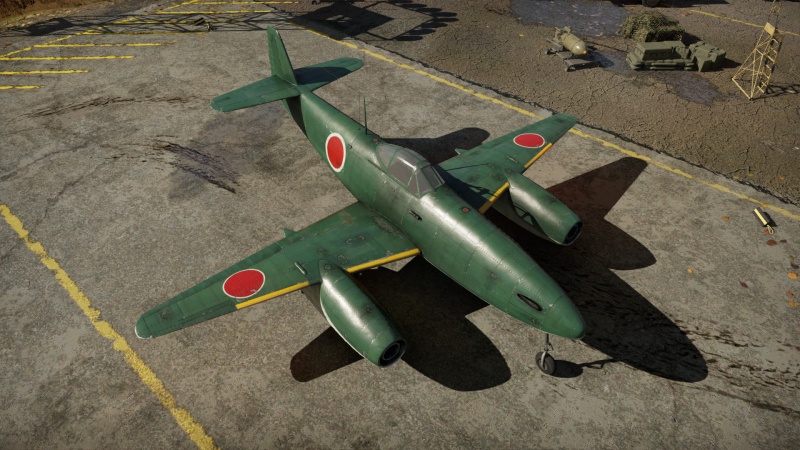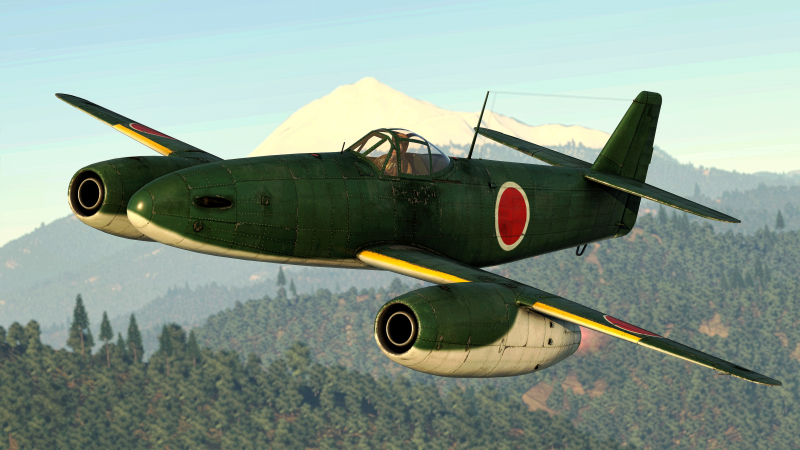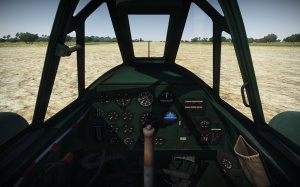Kikka
Contents
Description
The Kikka is the first Japanese jet and was a land-based attack plane developed by Nakajima for the IJNAS to attack US warships at high speed and close range with bombs. Taking inspiration from German jet development and advancement, the Kikka, contrary to common belief, was completely domestic in development and role for Japanese needs. Construction of the Kikka was simplified to allow unskilled labor and mass produce the jet plane to build up a large reserve of homeland defense and strike at American vessels. With the war ending, two prototypes were tested, 23 more proto-frames were under construction, and production halted.
In War Thunder, the Kikka is a fast and versatile fighter-bomber introduced in Update 1.43. It starts with a single 30 mm which can be modified with the 'otsu' mod equipping the second 30 mm. It is crucial to utilize speed, as that is its most significant advantage against most aircraft it encounters. While it can be loaded with up to 800 kg of bombs, it slows the jet down massively due to the added weight, which is not advisable for air combat; against naval and ground targets, it is crucial to dive in at high speed to come in and out while evading anti-air fire with speed.
General info
Flight performance
| Characteristics | Max speed (km/h at 0 m - sea level) |
Max altitude (metres) |
Turn time (seconds) |
Rate of climb (metres/second) |
Take-off run (metres) | |||
|---|---|---|---|---|---|---|---|---|
| AB | RB | AB | RB | AB | RB | |||
| Stock | 855 | 842 | 22.7 | 23.5 | 23.1 | 22.3 | 750 | |
| Upgraded | 894 | 875 | 21.8 | 22.0 | 29.1 | 26.0 | ||
Details
| Features | |||||
|---|---|---|---|---|---|
| Combat flaps | Take-off flaps | Landing flaps | Air brakes | Arrestor gear | Drogue chute |
| ✓ | ✓ | ✓ | X | X | X |
| Limits | ||||||
|---|---|---|---|---|---|---|
| Wings (km/h) | Gear (km/h) | Flaps (km/h) | Max Static G | |||
| Combat | Take-off | Landing | + | - | ||
| 558 | 529 | 380 | ~11 | ~5 | ||
| Optimal velocities (km/h) | |||
|---|---|---|---|
| Ailerons | Rudder | Elevators | Radiator |
| < 590 | < 590 | < 650 | N/A |
Engine performance
| Engine | Aircraft mass | |||||
|---|---|---|---|---|---|---|
| Engine name | Number | Empty mass | Wing loading (full fuel, no boosters) | |||
| Nakajima Ne-20 | 2 | 2,440 kg | 228 kg/m2 | |||
| Engine characteristics | Mass with fuel (no weapons load, no boosters) | Max Takeoff Weight | ||||
| Weight (each) | Type | 7m fuel | 20m fuel | 23m fuel | ||
| 470 kg | Axial-flow turbojet | 2,654 kg | 2,951 kg | 3,020 kg | 5,000 kg | |
| Maximum engine thrust @ 0 m (RB / SB) | Thrust to weight ratio @ 0 m (106%, no booster) | |||||
| Condition | 100% | 106% | 7m fuel | 20m fuel | 23m fuel | MTOW |
| Stationary | 572 kgf | 650 kgf | 0.49 | 0.44 | 0.43 | 0.26 |
| Optimal | 572 kgf (0 km/h) |
650 kgf (0 km/h) |
0.49 | 0.44 | 0.43 | 0.26 |
| Booster (Solid-fuel rocket) | Aircraft mass | |||||||
|---|---|---|---|---|---|---|---|---|
| Number | Booster weight (each) |
Fuel weight (each) |
Burn Time |
Can be shutdown |
Jettisoned after use |
Mass with full booster fuel (no weapons load) | ||
| 7m fuel | 20m fuel | 23m fuel | ||||||
| 2 | 50 kg | 350 kg | 6s | No | Yes | 3,454 kg | 3,751 kg | 3,820 kg |
| Condition | Maximum booster thrust @ 0 m (RB / SB) |
Combined engine & booster thrust @ 0 m |
Thrust to weight ratio @ 0 m (100% with booster) | |||||
| 7m fuel | 20m fuel | 23m fuel | ||||||
| Stationary | 816 kgf | 2,932 kgf | 0.85 | 0.78 | 0.77 | |||
| Optimal | 816 kgf (any speed) |
2,932 kgf (0 km/h) |
0.85 | 0.78 | 0.77 | |||
Survivability and armour
- 70 mm Bulletproof glass - Armoured windscreen
- 12.7 mm Steel plates in front of front fuel tank
- 12.7 mm Steel plate behind the pilot
- 12.7 mm Steel plate behind the rear fuel tank
Modifications and economy
- Otsu mod. allows the installation of a second 30 mm cannon
Due to the lacklustre firepower while stock, Kikka pilots should prioritize unlocking the Otsu mod as soon as possible. After this, you can either upgrade the flight performance, additional gun upgrades or bombs depending on your preference.
Armaments
Offensive armament
The Kikka is armed with:
- A choice between two presets:
- 1 x 30 mm Type 5 cannon, nose-mounted (50 rpg)
- 2 x 30 mm Type 5 cannon, nose-mounted (50 rpg = 100 total)
Suspended armament
The Kikka can be outfitted with the following ordnance:
- Without load
- 1 x 500 kg Navy Type Number 50 Model 2 bomb (500 kg total)
- 1 x 800 kg Navy Type Number 80 Model 1 bomb (800 kg total)
Usage in battles
The Kikka has a good acceleration rate for its BR, as well as climb rate, and low top speed compared to later jets. The pilot is quite heavily protected from the front and rear by both armour, and the fuel tanks are self sealing. The (wing mounted) engines, on the other hand, take damage easily, and minor damage to them will further slow the plane to speeds that some props can match.
Its 30 mm guns have a low rate of fire and low ammo count, but are very powerful and can down fighters with a few solid shots. The stock belt is lacking and it is recommended to research and use the tracer belt (HEF-T). There are no AP rounds, the closest thing being the "practice" shell, merely an unfilled HE shell. Strafing is discouraged as the guns simply arent a threat to anything but open-topped vehicles.
The Kikka should be played as a Boom & Zoomer. It has a great roll rate so it can still catch enemies that attempt to dodge it. Many pursuers can be outrun by going into a slight dive, and rolling to avoid enemy fire. Super props like the P-51H-5NA can catch the Kikka in certain situations, though the Kikka's top maintainable speed is much higher than theirs.
To attempt to gain the upper hand on a Kikka, propeller planes should dive from at least 2,000 m above the Kikka to be able to catch it. If the Kikka goes into a tight turn fight, it will generally bleed its energy, making it an easy target to be defeated by prop planes, which is usually the case when a jet attempt to engage a prop in a turnfight.
Pros and cons
Pros:
- Early jet fighter that can frequently see prop aircraft
- Can carry either a heavy 800 kg or a 500 kg bomb
- Can use flaps at high speeds (roughly 550 km/h = 341 mph)
- Good at diving as long as it has enough performance modules
- 30 mm cannons are hard hitters
- Good climb rate and vertical performance
- Great energy retention
- Good roll rate
- Exceptional cockpit visibility to the sides/rear
Cons:
- Limited ammo, only 50 shells per gun
- Somewhat poor turn rate
- Only one 30 mm gun when stock
- Adding payload will hinder handling significantly due to the planes light weight and small size
- Slow if compared to later jets
- Prop planes will out turn you
- Cockpit visibility to the front is noticeably obstructed, with an extremely crude sight in the form of a stick
History
The Nakajima Kikka was Japan's first entirely turbojet-powered aircraft, designed as a cheap and fast special attack plane for envisioned decisive battles in the defense of Japan. Whilst a general resemblance can be seen to the German Me 262 Schwalbe, this is only due to superficial characteristics such as the under-wing engine nacelles and roughly triangular fuselage. In terms of detailed structural design, the two are not directly related.
The Japanese were not able to receive all of the information that was provided through a negotiation on 1944 with the German high command over the licensing for the BMW 003 and Junkers Jumo 004 turbojet engines. Examples and plans were lost with the sinking of submarines that carried the important cargo, however all was not completely lost. A single BMW 003A diagram was saved as it was flown in to Japan separate from the submarine I-29. Upon further inspection of the BMW 003A diagram, the Japanese designers were able to garner enough information in compound with their previous developments to lay out the plans of more feasible turbojets.
This plane is sometimes incorrectly identified in IJN designation as J9N or J9Y, but, like all other Japanese "special attack" (suicide) planes, it was only given the formal name of Kikka ("橘花"). It was formerly called "Kōkoku Nigō Heiki" (興国二号兵器, "Prospering Country Mk.2 Weapon")
Work began on newer engine designs. Ultimately the Kūgishō Ne-20 engine was the one selected which was a Japanese design based on the format of the BMW 003A. The Kikka was developed as a special attack plane to attack vessels from invading fleets. The airframe was simple to mass-produce, and the engines could operate on low-grade fuels. The armament consisted of only a single 500 or 800 kg bomb. However, the prototype aircraft would not fly until August 7th 1945, by which time the Japanese were rapidly running out of time. It would attempt flight again on August 11th 1945, but was heavily damaged during an aborted takeoff due to trouble with the RATO units. That would be the last time the aircraft would fly again as just days later, the surrender of Japan was broadcast over the radio, signalling the end of the Kikka development.
A fighter variant for intercepting B-29s with improved Ne-20 Kai engines and two Type 5 30 mm cannons was under development during 1945, but the war ended before there was a prospect of completing it.
Media
- Skins
- Videos
See also
External links
- Official data sheet - more details about the performance
- [Aviation of Word War II] J8N Kitsuka
- [SENSHA blog] Japan's First Jet Plane · [Part 1] · [Part 2] · [Part 3]
| Nakajima Aircraft Company (中島飛行機株式会社 ) | |
|---|---|
| Fighters | Ki-27 otsu · Ki-27 otsu Tachiarai |
| Ki-43-I · Ki-43-II · Ki-43-III otsu | |
| Ki-44-I · Ki-44-I 34 · Ki-44-II otsu · Ki-44-II hei | |
| Ki-84 ko · Ki-84 otsu · Ki-84 hei | |
| Ki-87 | |
| Hydroplanes | A6M2-N* |
| Interceptors | J1N1 · J5N1 |
| Bombers | B5N2 |
| B6N1 Model 11 · B6N2 Model 12 · B6N2a Model 12Ko | |
| G5N1 · G8N1 | |
| Ki-49-I · Ki-49-IIa · Ki-49-IIb · Ki-49-IIb/L | |
| Recon | E8N2 |
| Jet Fighters | Kikka |
| Captured | ␗Ki-27 otsu · ▃Ki-43-II · ␗Ki-43-III ko · ␗Ki-44-II hei · ␗Ki-84 ko |
| *Refit of the Mitsubishi A6M2 mod. 11 | |
| See also | Fuji Heavy Industries (1957-2017) |
| Japan jet aircraft | |
|---|---|
| IJNAS | |
| Experimental | Kikka |
| Reconnaissance | R2Y2 Kai V1 · R2Y2 Kai V2 · R2Y2 Kai V3 |
| IJAAS | |
| Fighters | Ki-200 |
| JASDF | |
| Fighters | F-86F-30 ▅ · F-86F-40 ▅ · F-86F-40 JASDF▅ |
| F-104J | |
| F-4EJ Phantom II · F-4EJ ADTW · F-4EJ Kai Phantom II | |
| F-15J · F-15J(M) | |
| F-16AJ | |
| F-1 | |
| Trainers | T-2 Early · T-2 |
| Foreign | |
| Thailand | ▄AV-8S · ▄F-5E FCU |









